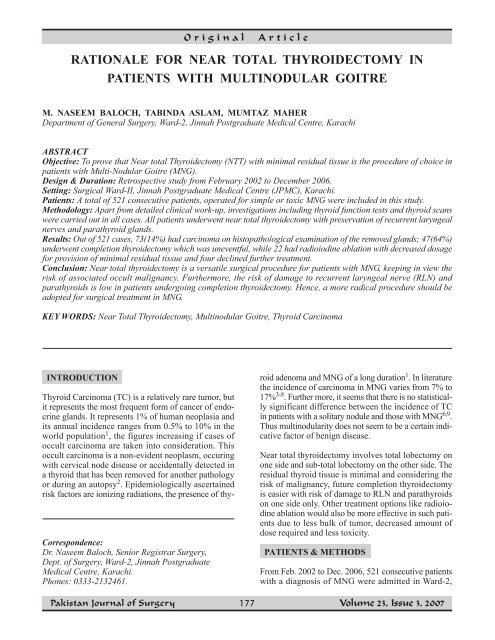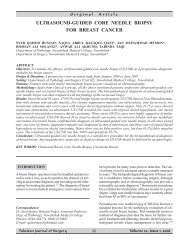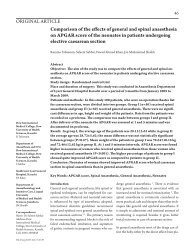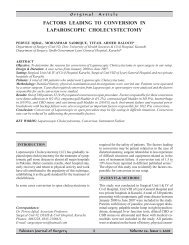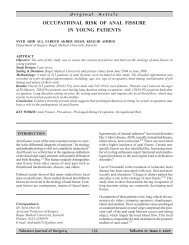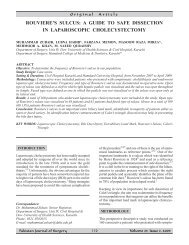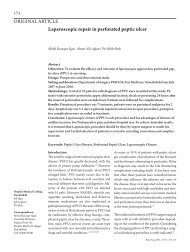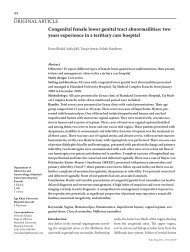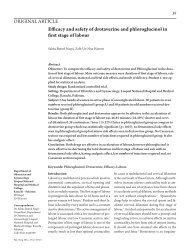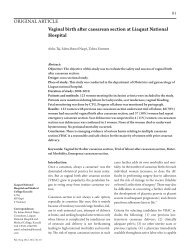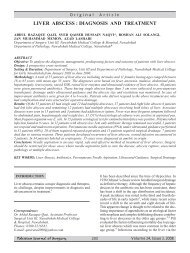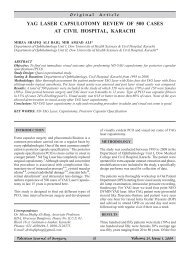rationale for near total thyroidectomy in patients with multinodular ...
rationale for near total thyroidectomy in patients with multinodular ...
rationale for near total thyroidectomy in patients with multinodular ...
- No tags were found...
Create successful ePaper yourself
Turn your PDF publications into a flip-book with our unique Google optimized e-Paper software.
Orig<strong>in</strong>alArticleRATIONALE FOR NEAR TOTAL THYROIDECTOMY INPATIENTS WITH MULTINODULAR GOITREM. NASEEM BALOCH, TABINDA ASLAM, MUMTAZ MAHERDepartment of General Surgery, Ward-2, J<strong>in</strong>nah Postgraduate Medical Centre, KarachiABSTRACTObjective: To prove that Near <strong>total</strong> Thyroidectomy (NTT) <strong>with</strong> m<strong>in</strong>imal residual tissue is the procedure of choice <strong>in</strong><strong>patients</strong> <strong>with</strong> Multi-Nodular Goitre (MNG).Design & Duration: Retrospective study from February 2002 to December 2006.Sett<strong>in</strong>g: Surgical Ward-II, J<strong>in</strong>nah Postgraduate Medical Centre (JPMC), Karachi.Patients: A <strong>total</strong> of 521 consecutive <strong>patients</strong>, operated <strong>for</strong> simple or toxic MNG were <strong>in</strong>cluded <strong>in</strong> this study.Methodology: Apart from detailed cl<strong>in</strong>ical work-up, <strong>in</strong>vestigations <strong>in</strong>clud<strong>in</strong>g thyroid function tests and thyroid scanswere carried out <strong>in</strong> all cases. All <strong>patients</strong> underwent <strong>near</strong> <strong>total</strong> <strong>thyroidectomy</strong> <strong>with</strong> preservation of recurrent laryngealnerves and parathyroid glands.Results: Out of 521 cases, 73(14%) had carc<strong>in</strong>oma on histopathological exam<strong>in</strong>ation of the removed glands; 47(64%)underwent completion <strong>thyroidectomy</strong> which was uneventful, while 22 had radioiod<strong>in</strong>e ablation <strong>with</strong> decreased dosage<strong>for</strong> provision of m<strong>in</strong>imal residual tissue and four decl<strong>in</strong>ed further treatment.Conclusion: Near <strong>total</strong> <strong>thyroidectomy</strong> is a versatile surgical procedure <strong>for</strong> <strong>patients</strong> <strong>with</strong> MNG, keep<strong>in</strong>g <strong>in</strong> view therisk of associated occult malignancy. Furthermore, the risk of damage to recurrent laryngeal nerve (RLN) andparathyroids is low <strong>in</strong> <strong>patients</strong> undergo<strong>in</strong>g completion <strong>thyroidectomy</strong>. Hence, a more radical procedure should beadopted <strong>for</strong> surgical treatment <strong>in</strong> MNG.KEY WORDS: Near Total Thyroidectomy, Mult<strong>in</strong>odular Goitre, Thyroid Carc<strong>in</strong>omaINTRODUCTIONThyroid Carc<strong>in</strong>oma (TC) is a relatively rare tumor, butit represents the most frequent <strong>for</strong>m of cancer of endocr<strong>in</strong>eglands. It represents 1% of human neoplasia andits annual <strong>in</strong>cidence ranges from 0.5% to 10% <strong>in</strong> theworld population 1 , the figures <strong>in</strong>creas<strong>in</strong>g if cases ofoccult carc<strong>in</strong>oma are taken <strong>in</strong>to consideration. Thisoccult carc<strong>in</strong>oma is a non-evident neoplasm, occur<strong>in</strong>g<strong>with</strong> cervical node disease or accidentally detected <strong>in</strong>a thyroid that has been removed <strong>for</strong> another pathologyor dur<strong>in</strong>g an autopsy 2 . Epidemiologically ascerta<strong>in</strong>edrisk factors are ioniz<strong>in</strong>g radiations, the presence of thy-Correspondence:Dr. Naseem Baloch, Senior Registrar Surgery,Dept. of Surgery, Ward-2, J<strong>in</strong>nah PostgraduateMedical Centre, Karachi.Phones: 0333-2132461.roid adenoma and MNG of a long duration 1 . In literaturethe <strong>in</strong>cidence of carc<strong>in</strong>oma <strong>in</strong> MNG varies from 7% to17% 3-8 . Further more, it seems that there is no statisticallysignificant difference between the <strong>in</strong>cidence of TC<strong>in</strong> <strong>patients</strong> <strong>with</strong> a solitary nodule and those <strong>with</strong> MNG 6,9 .Thus mult<strong>in</strong>odularity does not seem to be a certa<strong>in</strong> <strong>in</strong>dicativefactor of benign disease.Near <strong>total</strong> <strong>thyroidectomy</strong> <strong>in</strong>volves <strong>total</strong> lobectomy onone side and sub-<strong>total</strong> lobectomy on the other side. Theresidual thyroid tissue is m<strong>in</strong>imal and consider<strong>in</strong>g therisk of malignancy, future completion <strong>thyroidectomy</strong>is easier <strong>with</strong> risk of damage to RLN and parathyroidson one side only. Other treatment options like radioiod<strong>in</strong>eablation would also be more effective <strong>in</strong> such <strong>patients</strong>due to less bulk of tumor, decreased amount ofdose required and less toxicity.PATIENTS & METHODSFrom Feb. 2002 to Dec. 2006, 521 consecutive <strong>patients</strong><strong>with</strong> a diagnosis of MNG were admitted <strong>in</strong> Ward-2,177Volume 23, Issue 3, 2007
Rationale <strong>for</strong> Near Total ThyroidectomyJPMC. Cl<strong>in</strong>ical workup and <strong>in</strong>vestigations <strong>in</strong>clud<strong>in</strong>gthyroid function tests and thyroid scans were carriedout <strong>in</strong> all these cases; 502 <strong>patients</strong> were euthyroid whilethe rema<strong>in</strong><strong>in</strong>g 19 had mildly <strong>in</strong>creased T 4levels, andwere stabilized. Of the present<strong>in</strong>g symptoms, swell<strong>in</strong>g<strong>in</strong> front of the neck was the chief compla<strong>in</strong>t <strong>in</strong> all thecases followed by symptoms of hyperthyroidism, pa<strong>in</strong>and difficulty <strong>in</strong> swallow<strong>in</strong>g.All the <strong>patients</strong> underwent <strong>near</strong> <strong>total</strong> <strong>thyroidectomy</strong>,<strong>with</strong> preservation of the recurrent laryngeal nerves andparathyroid glands. The maximum post-operative hospitalstay was 48 hours and no post-operative complicationwas recorded. Histopathology of the excised specimenwas received <strong>in</strong> 20 days, and further management <strong>in</strong>the <strong>for</strong>m of either completion <strong>thyroidectomy</strong> or radioiod<strong>in</strong>eablation was carried out <strong>with</strong><strong>in</strong> a month, after an<strong>in</strong><strong>for</strong>med and written consent from patient.RESULTSOf the 521 <strong>patients</strong> who underwent Near <strong>total</strong> Thyroidectomy,73 (14%) were found to have a carc<strong>in</strong>oma on histopathologicalexam<strong>in</strong>ation of the removed glands. Itwas papillary carc<strong>in</strong>oma <strong>in</strong> 60 cases, follicular <strong>in</strong> eightand undifferentiated carc<strong>in</strong>oma <strong>in</strong> five cases.Out of the 73 <strong>patients</strong>, 47 (64%) underwent completion<strong>thyroidectomy</strong>. In these <strong>patients</strong>, dissection was carriedout on one side only and there was no s<strong>in</strong>gle case ofdamage to RLN or parathyroid glands. Vocal cords mobilitywas checked dur<strong>in</strong>g extubation. Post-operativehospital stay was 48 hours on an average <strong>in</strong> these cases,three days be<strong>in</strong>g the maximum. These <strong>patients</strong> werefollowed <strong>in</strong> the Outpatient Dept. and their serum calciumlevels post-operatively were <strong>in</strong> the range of 8-10 mg/dl.Twenty two <strong>patients</strong>, out of the 73, went <strong>for</strong> radioiod<strong>in</strong>eablation, which was given <strong>in</strong> a low dose due to the smallbulk of the residual thyroid tissue; consequently littletoxicity, if any, occurred. The rema<strong>in</strong><strong>in</strong>g four <strong>patients</strong>refused any further treatment.DISCUSSIONTraditionally <strong>patients</strong> <strong>with</strong> MNG have been consideredless at risk of malignancy than those <strong>with</strong> s<strong>in</strong>gle nodule.However, published reports show that the <strong>in</strong>cidence ofmalignant tumors <strong>in</strong> <strong>patients</strong> <strong>with</strong> s<strong>in</strong>gle nodule doesnot differ much from those <strong>with</strong> MNG 6,9 . MNG is arisk factor <strong>for</strong> epidemiologically ascerta<strong>in</strong>ed TC 1 . Infact,the <strong>in</strong>duction of TC follow<strong>in</strong>g a diet lack<strong>in</strong>g <strong>in</strong> Iod<strong>in</strong>ewas demonstrated <strong>in</strong> mice and a confirmation is givenby the reduction of the mortality rate <strong>for</strong> TC registered<strong>in</strong> Switzerland follow<strong>in</strong>g the supplement of iod<strong>in</strong>e <strong>in</strong>M. N. Baloch, T. Aslam, M. Maherthe table salt 10 . Epidemiological studies have demonstratedthat the <strong>in</strong>cidence of carc<strong>in</strong>oma <strong>in</strong> <strong>patients</strong> <strong>with</strong>MNG is higher than that of the <strong>in</strong>cidence <strong>in</strong> the generalpopulation 11,12 .In our retrospective analysis of 521 <strong>patients</strong> operated<strong>for</strong> MNG, 14% were found to have a carc<strong>in</strong>oma on def<strong>in</strong>itivehistopathological exam<strong>in</strong>ation. This <strong>in</strong>cidence isnot significantly different from the risk of malignancy<strong>in</strong> solitary nodules 6,9 . Adoption of a more radical procedure<strong>in</strong> solitary nodule is justified by the risk of malignancy<strong>in</strong> it. Our study showed no significant difference<strong>in</strong> this risk <strong>in</strong> MNG. Hence a more radical procedure isjustified <strong>in</strong> MNG as well.Damage to the RLN is the most feared complicationwhile operat<strong>in</strong>g on the thyroid gland. Its complicationmay vary from simple neuropraxia to death. Conserv<strong>in</strong>ga nerve is more likely when operat<strong>in</strong>g on a gland thathas not been previously explored.Adoption of a radical procedure <strong>in</strong> the first <strong>in</strong>stance letsthe surgeon identify and preserve the nerve on bothsides so that when a completion <strong>thyroidectomy</strong> is to betaken, only one side will need to be explored. Even ifan <strong>in</strong>advertent damage occurs to the nerve, that will beunilateral only. Same is the case <strong>with</strong> parathyroids andtheir preservation can prevent the need of life long calciumreplacement <strong>in</strong> <strong>patients</strong>.CONCLUSIONThe risk of malignancy <strong>in</strong> MNG should not be underestimated, and the dom<strong>in</strong>ant nodule <strong>in</strong> MNG should beregarded as a solitary nodule <strong>in</strong> an otherwise normalgland so that a more radical procedure could be adopted.Our results suggest that <strong>near</strong> <strong>total</strong> <strong>thyroidectomy</strong> <strong>with</strong>m<strong>in</strong>imal residual tissue is a versatile surgical procedure<strong>for</strong> <strong>patients</strong> <strong>with</strong> mult<strong>in</strong>odular goitre <strong>with</strong> low risk ofcomplications.REFERENCES1. Franceschi S. Epidemiologia del Carc<strong>in</strong>oma dellaTiroide. In: Miani P, ed. Carc<strong>in</strong>oma della Tiroide.Pisa: Pac<strong>in</strong>i Editore; 1992. p.13-29.2. Miani P, Piemonte M, Bacchi G, Miani C. Fattoriprognostici e risultati terapeutici nel Carc<strong>in</strong>omadella Tiroide. In: Miani P, ed. Carc<strong>in</strong>oma della Tiroide.Pisa: Pac<strong>in</strong>i Editore; 1992. p.167-97.3. Cole WH. Incidence of Carc<strong>in</strong>oma of the Thyroidgland <strong>in</strong> nodular goiter. Sem<strong>in</strong> Surg Oncol 1991;7(2): 61-3.178Volume 23, Issue 3, 2007
Rationale <strong>for</strong> Near Total Thyroidectomy4. Koh KB, Chang KW. Carc<strong>in</strong>oma <strong>in</strong> Mult<strong>in</strong>odularGoitre. Br J Surg 1992; 79(3): 266-7.5. Mathai V, Idikula J, Fenn S, Nair A. Do long-stand<strong>in</strong>gNodular Goitres result <strong>in</strong> malignancies? AustNZ J Surg 1994; 64: 180-2.6. McCall A, Jarosz H, Lawrence AM, Paloyan E.The <strong>in</strong>cidence of Thyroid Carc<strong>in</strong>oma <strong>in</strong> solitarycold nodules and <strong>in</strong> Mult<strong>in</strong>odular Goiters. Surgery1986; 100(6): 1128-32.7. Pelizzo MR, Toniato A, Piotto A, Bernante P. Cancer<strong>in</strong> Mult<strong>in</strong>odular Goiter. Ann Ital Chir 1996; 67 (3):351-6.8. Sachmechi I, Miller E, Varatharajah R, et al. ThyroidM. N. Baloch, T. Aslam, M. MaherCarc<strong>in</strong>oma <strong>in</strong> s<strong>in</strong>gle cold nodules and <strong>in</strong> cold nodulesof Mult<strong>in</strong>odular Goiters. Endocr Pract 2000; 6 (1):110-2.9. Hosse<strong>in</strong> G. Chang<strong>in</strong>g concepts <strong>in</strong> the diagnosis andmanagement of the thyroid nodules. Endocr<strong>in</strong>olMetabolism Cl<strong>in</strong> N Am 1997; 26(4): 777-800.10. Franceschi S, Talam<strong>in</strong>i R, Frass<strong>in</strong>a A, Bidoli E.Diet and epithelial cancer of the Thyroid gland.Tumori 1990; 76: 331-8.11. Francis SG. The problem of nodular Goitre. MedCl<strong>in</strong> N Am 1991; 75: 195-209.12. Clark OH, Quan-Yang D. Thyroid Cancer. MedCl<strong>in</strong> N Am 1991; 75: 211-34.179Volume 23, Issue 3, 2007


